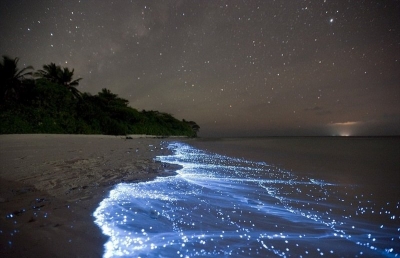
Blue tide and algal bloom
You may have often come across news about beach visitors witnessing glowing blue waves. This phenomenon is called blue tide and is caused when an abundance of marine noctilucent algae emit light in a chemical process called bioluminescence. The algae emit light when disturbed (by the waves in this case). It is an antipredatory response and is assumed to startle predators.
Though it may look magical, it is an ecological indicator of degraded water quality. Factors such as the pattern of the wind and higher sea temperature also determine the occurrence of algal bloom and bioluminescent waves.
What causes this algal bloom? When humans channel agricultural runoff, sewage and industrial effluents into waterways, the amount of nutrients in the water increases. The excess nutrients, especially nitrogen and phosphorous, lead to a spurt in the growth of microscopic algae. This is called algal bloom. Some of these can be bioluminescent. Not all algal blooms are harmful, but some are deadly. The presence of so many algae may suffocate fish by clogging or irritating the gills. Some algal species produce deadly toxins which either kill the animals or accumulate in the body of animals and spread through the food web.
Sea snot
Recently, there has been growing environmental concern in Turkey over the accumulation of ‘sea snot, in the country’s seas, which can cause considerable damage to the marine ecosystem.
“Sea snot”, or marine mucilage, is a naturally occurring green sludge that forms when algae is overloaded with nutrients as a result of hot weather and water pollution. Most marine organisms produce mucus. But in unpolluted waters, mucus doesn’t amass to large proportions. The current sea-snot outbreak can be blamed on phytoplankton, a type of algae that produces the small bits of mucus that turn into flakes of marine snow. During an algal bloom, they make an overabundance of mucus. Beads of that mucus can accumulate into sheets and wash up shore.
Sea snot affect marine and coastal ecosystem. It could poison the mussels and creatures such as crabs. It also affects fishing and tourism.
Sea foam
Sea foam is a type of foam created by the agitation of seawater, particularly when it contains higher concentrations of dissolved organic matter derived from sources such as the decay of offshore algal blooms. Sea foam forms when the ocean is churned by wind and waves. As a result, great amounts of decaying algal matter wash ashore.
Most sea foam is not harmful to humans, but when large harmful algal blooms decay near shore, there are potential for impacts to human health and the environment. The resulting aerosol can irritate the eyes and pose a health risk for those with respiratory conditions.
Sargassum
In the centre of the North Atlantic ocean, amidst the vast blue expanse, is a huge floating mat of brown seaweed called sargassum. These mats are quite common in the Sargasso Sea, a region around Bermuda. But since 2011, the Atlantic Ocean has been witnessing massive sargassum blooms every year. It stretches nearly 9000 km from West Africa to the Gulf of Mexico. Scientists call this the Great Atlantic Sargassum Belt. The seaweed band has been getting bigger every year, posing a serious threat to marine life, coastal ecosystem and the fishing communities dependent on it. The seaweeds often wash up ashore en masse and choke coastal ecosystems. As the seaweed rots, it releases foul-smelling hydrogen sulphide gas, causing respiratory illness in local populations. It also affects coastal tourism.
Removal is time-consuming, expensive, and not always effective. Scientists attribute it various factors such as warming of the ocean due to climate change, discharge of nutrients from agricultural runoff.
Ghost forests
Grey and barren dead trees are dotting coastal regions across many parts of the world. Called ghost forests, these are leafless, limbless trees that can last decades in this dried-up barren state. Scientists believe they are the immediate consequences of sea-level rise. Sea-level rise increases the risk of saltwater intrusion. It is the flow of seawater into wetlands and rivers. As sea level rises, more and more saltwater encroaches on the land and overtakes freshwater that trees rely upon for sustenance. The salty water slowly poisons trees and eventually kills them. (Dead trees with pale trunks are a telltale sign of high salt levels in the soil.) The rising salt water also leaves soil unhealthy and forests unsuitable for new growth. Scientists note that extreme weather events, fuelled by climate change, are causing further damage to vegetation in the form of heavy storms, more frequent hurricanes and drought. This is causing mass tree die-offs across coastal regions.
Picture Credit : Google




